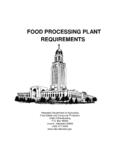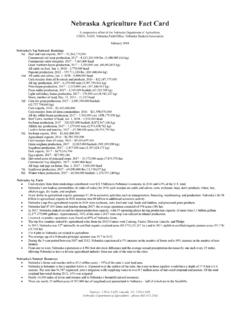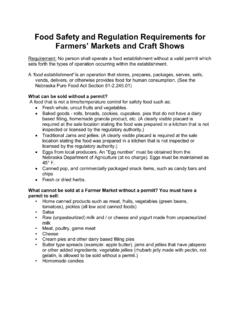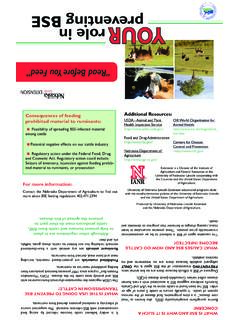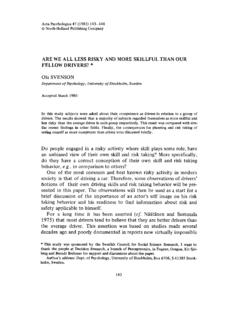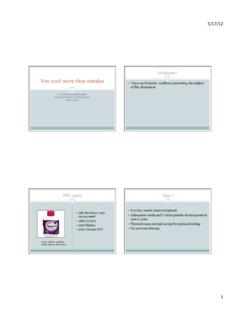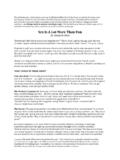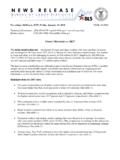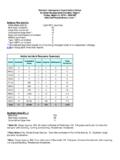Transcription of Table of Contents - Nebraska
1 Table of Contents Nebraska Defined by Geography & Weather & Ethanol & Nebraska 's Livestock & Crops Sheep & Poultry & Alfalfa & Dry Edible Sugar Grain Christmas Wine Fruits & Proso Cover: The Dixon family, from Pleasanton, Nebraska . 2 3. Nebraska . DEFINED BY AGRICULTURE. Nebraska agriculture has been described as expansive and diverse with an Nebraska also leads the way in production of many other crops and abundance of natural resources. The landscape varies from large pastures livestock. It has been the number-one producer in the United States dotted with feeding cattle, to miles of rolling hills bursting with a wide variety of popcorn and Great Northern beans, and among the state leaders in of crops, and everything in-between. producing soybeans, wheat, dry edible beans, pork, grain sorghum and eggs. But while Nebraska has everything needed to support all types of agriculture, The diverse range of agriculture products produced in Nebraska is due in including an abundant water supply and ample amounts of cropland and part to the varying topography and changes in climate.
2 There is a significant pasture, many would say its most important asset is its people. drop in elevation from west to east in Nebraska . This results not only in differences in climatic conditions, but also in soil type and landscape. Farms and ranches in Nebraska have been handed down from generation to generation, and families still serve as the hub of the state's number one When it comes to weather in Nebraska , it is best described by an old saying industry, agriculture. Known for a hard-work ethic and a strong set of values, that goes, If you don't like the weather, just wait a minute, it will change.. these families continue to produce the highest quality food products that Conditions can change from cloudy to sunny, from windy to calm, and help feed the world. cold to warm in a single day. The state also features all four seasons, giving Nebraskans the chance to enjoy a true variety of what nature has to offer.
3 All Nebraskans seem to be connected to agriculture in one way or another. If they didn't come from a farm background, they are probably related While Nebraska is the 16th largest state by area in the United States (77,358. to someone who did. Or they could very well work in the industry in a sq. mi), it has a relatively small population at approximately million. And supporting role. After all, one in four jobs in the state is agriculture-related. it is estimated that three-quarters of that population resides in one-fourth of the state's area. That unique makeup provides the perfect setting for There is a wide span of agricultural jobs in Nebraska , including careers in agriculture. the areas of insurance, equipment sales and repair, technology, irrigation, engineering and many more. Agri-business is vital to the state's economy and Welcome to Nebraska . Welcome to Nebraska agriculture.
4 Having a ready and willing workforce has helped those businesses thrive. Nebraska also has the infrastructure needed to transport grain, livestock and all types of agricultural products to their intended destination. The railroads, semis, trucks and other vehicles have the necessary pathways to move from east to west and north to south throughout the state. With monikers like Cornhuskers and The Beef State, it doesn't take long to figure out corn and cattle are two of the top commodities produced in Nebraska . The state has been among the leading producers in each category nationally for many years. The ready supply of corn as feed for the cattle results in producing premium-quality meat products, which are sought by consumers throughout the world. 4 5. Geography From picturesque rolling hills, to fertile valleys, to expansive plains, to the 430 mile distance from Panorama Point in the west, to the southeast corner awe-inspiring Sandhills, the geography of Nebraska is one of the most of the state along the Kansas border.
5 Nebraska also borders the magnificent unique in the United States. The landscape changes dramatically, especially Missouri River and is home to the unique Platte River ecosystem, as well as traveling from west to east. There is an elevation drop of 4,584 feet in the massive Lake McConaughy, which covers a surface area of 35,700 acres. Soil Nebraska 's topsoil is primarily loam, which is a combination of clay, silt and primarily produced in those regions. Portions of western and northwest sand. However, the proportions of those components can vary in different Nebraska are predominantly sand, while areas to the east have more clay. All areas of the state, which will often dictate whether crops or livestock are areas in between are a combination of sand, clay and silt. 6 7. Weather & Climate Nebraskans are fortunate to enjoy all four seasons: spring, summer, fall and winter.
6 While these seasonal changes can bring challenging weather at times, including thunderstorms and snowfall, it also opens up the door for diverse and sustainable agriculture. Meanwhile Nebraska 's climatic conditions vary greatly from one end of the state to the other due to a significant drop in elevation from west to east. For instance, in northwest Nebraska , where the elevation reaches over 3,400 feet above sea level, the humidity levels are relatively low and the annual average rainfall is 18 inches. In the southeast corner of the state where elevation is only 840 feet above sea level, the average annual rainfall is much higher at over 30 inches. Groundwater One of Nebraska 's most vital natural resources is its massive supply of groundwater. The High Plains Aquifer, also commonly referred to as the Ogallala Aquifer, stretches through parts of eight states, but its most abundant water resource is located in nearly two-thirds of Nebraska .
7 This groundwater availability has been essential to the success of agriculture in the state. Center pivot irrigation is the most common method of providing water to row crops in the state, and as a result, four of the largest manufacturers of center pivot systems in the world are located in Nebraska . An accessible water supply also is vital to Nebraska 's livestock and dairy production. 8 9. Ethanol Nebraska is the second largest ethanol producing state in the nation. With approximately 25 operating ethanol plants utilizing the state's abundance of corn as the main feedstock, Nebraska produces more than 2 billion gallons of renewable fuel annually. Meanwhile, distillers' grains, a co-product of ethanol production, is important as both a domestic livestock feed ingredient and as a foreign export product. The linkage between corn, ethanol and livestock production has become known as Nebraska 's Golden Triangle.
8 Transportation A solid transportation infrastructure is critical to the success of Nebraska agriculture. Two major railroad lines, Union Pacific and BNSF, have well- established track systems throughout the state. Interstate 80 carries vehicle traffic non-stop from east to west, while two other major highways facilitate north/south movement through Nebraska . There also are major airports in Omaha and Lincoln, as well as barge transportation along the Missouri River on the eastern border. 10 11. BEEF PORK. Beef production is the largest sector of agriculture in Nebraska , and Nebraska 's pork industry plays an important role in the state's agricultural Nebraska is the only state that is a national leader in every aspect of beef economy. Pig farms vary in size and how the pig is raised. In Nebraska there production: cow/calf, backgrounding, corn growing, cattle feeding and are more than million pigs.
9 Advances in animal genetics, technology and processing. Calves born on one of Nebraska 's 19,000 cow/calf ranches management practices have changed, leading to leaner and more nutritious typically spend the majority of their lives on grass before being sent to a pork. Six of the most common cuts of pork have, on average, 16 percent feedlot for finishing. Cattle typically spend 3-6 months in the feedlot being less fat and 27 percent less saturated fat than 20 years ago. fed a balanced ration of corn, forages, distillers' grains, and vitamin and mineral supplements. Corn feeding allows Nebraska producers to get greater marbling and tenderness in the final beef product. Corn-fed Nebraska beef is known worldwide for its flavor, tenderness Nebraska 's pork industry generates more than $1 billion in annual cash and quality. receipts. Nebraska 's beef industry generates Pork is consumed by more people worldwide than approximately $ billion in annual any other meat.
10 Cash receipts. Nebraska has the 6th largest swine herd in the Cattle outnumber people in Nebraska country. more than three to one. Every part of a cow is used for a wide variety of products, including leather, fishing line, biodegradable outboard motor oil, pet chew toys and gummy candies. 12 13. DAIRY SHEEP & GOATS. Virtually all of Nebraska 's dairy farms are family owned and operated. Dairy Nebraska 's sheep herds and goat herds provide a source of both food farms will recycle and re-use many production inputs, such as sand that is and fiber. Meat from sheep, called lamb or mutton, is high in protein. used for bedding and water which will be used multiple times - from drinking Consumption is typically greater in the larger population centers, especially to cleaning - before being used to irrigate crops. Since cows are milked two on the east and west coasts. Goat meat, or chevon, is a staple in some foreign to three times per day and milk is perishable, dairy farms tend to locate near countries and a delicacy in others.
